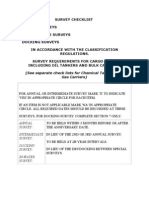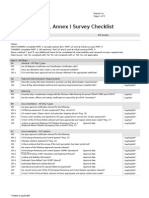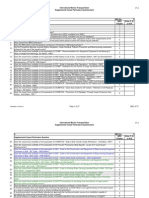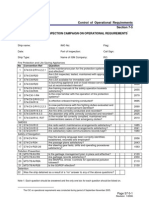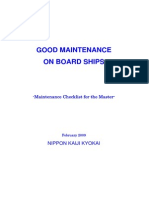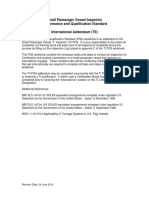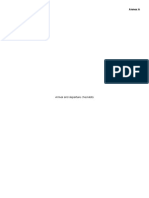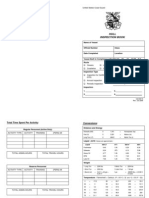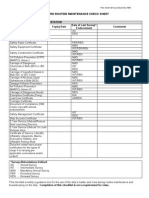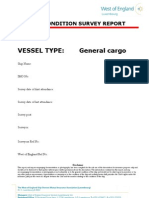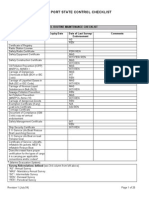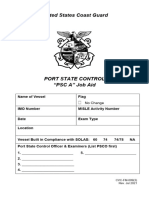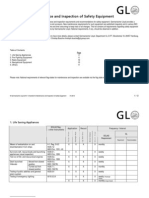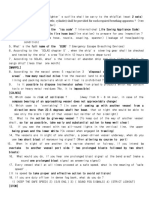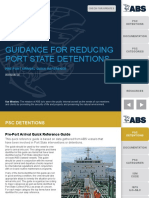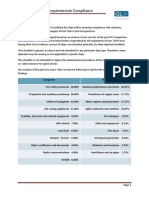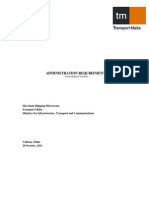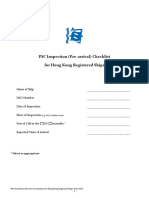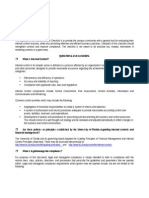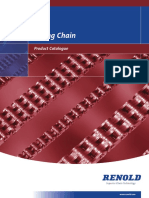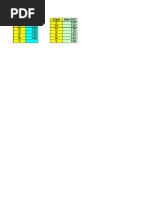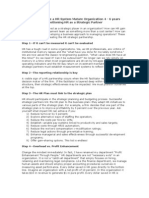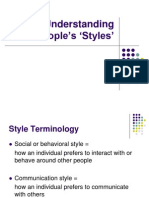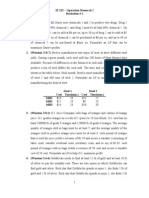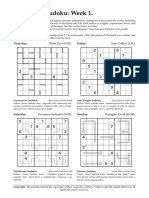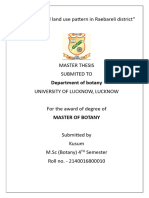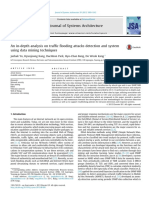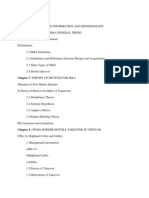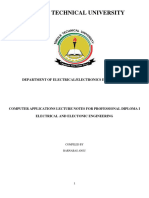Inland 11
Inland 11
Uploaded by
Bob ForeverCopyright:
Available Formats
Inland 11
Inland 11
Uploaded by
Bob ForeverOriginal Description:
Copyright
Available Formats
Share this document
Did you find this document useful?
Is this content inappropriate?
Copyright:
Available Formats
Inland 11
Inland 11
Uploaded by
Bob ForeverCopyright:
Available Formats
AWO Responsible Carrier Program Audit Checklist
Section II: Inland Towing Vessel Questionnaire
Table of Contents
1. Introduction and Company Overview 2. Vessel Particulars 3. Navigation and Communication Equipment 4. Firefighting and Lifesaving Equipment 5. Environmental Controls 6. Machinery 7. Towboat Hull 8. Boat and Barge Rigging 9. Manning 10. Watchstanding and Work Hours 11. Training
Revised 04/11
RCP Audit Inland Towing Vessel Checklist
1. Introduction and Company Overview
1 Company Particulars:
Company name / address:
Company phone number: Company fax number: 2 Names of persons participating in this audit:
Briefly describe the marine service provided to various customers:
Briefly describe the nature of equipment and area of operations: Indicate: Coastal ____ Great Lakes____Inland ____ Harbor ____ Dry ____ Liquid ____
-1-
Revised 04/11
RCP Audit Inland Towing Vessel Checklist
1. Introduction and Company Overview (Continued)
5 Vessel Operations: Number of vessels owned or bareboat chartered in by company Barges Towboats/Tugboats Number of vessels chartered in by company and operated with non-employees Barges Towboats/Tugboats Approximate percentage of in-chartered vessels operated by non-employees that comply with the provisions of the Responsible Carrier Program Approximate number of company vessel employees Number of shore-based employees Y Attach an organizational flow chart depicting key individuals and their general function in the company (If not available, please check "N") 6 Prepared By: N
Attached?
Name of auditor(s):
Title: Company: Address:
Phone: Signature(s): Date:
-2-
Revised 04/11
RCP Audit Inland Towing Vessel Checklist
2. Vessel Particulars
Vessel Name: Year Built: Official Number: Length: Breadth: Where: Construction: (steel, wood, etc.) Depth:
Main Engine(s) Type: Auxiliary Engine(s) Type: Propulsion: Cylinders: Rated Horsepower/KW: Cylinders: Rated Horsepower/KW:
Remarks:
-3-
Revised 04/11
RCP Audit Inland Towing Vessel Checklist
3. Navigation and Communication Equipment
Is a check-off report turned in or a log entry made at least quarterly verifying that required navigation and communication equipment is present and in good working order? (RCP III-D) Is a copy of Navigation Rules on board? (RCP III-D-1) Are current or corrected navigation charts or maps on board? (33 CFR 164.72(b)(1)) (RCP III-D-11) Are copies of tide and current tables on board? (not required for W estern Rivers towing vessels) (33 CFR 164.72 (b)(3)) (RCP III-D-12) Is there a copy of the Coast Pilot? (not required for W estern Rivers towing vessels)
(33 CFR 164.72 (b)(3)) (RCP III-D-13)
Yes
No
Is a copy of the radiotelephone log maintained? (where applicable) (47 CFR 80.405, 80.409(e) and (f))
(RCP III-D-2)
Is the vessel equipped with a VHF radio in good working order? (33 CFR 164.72 (a)(3))
(RCP III-D-3)
Is a valid FCC radio station license posted? (47 CFR 80.25) (RCP III-D-4) Is the original Certificate of Documentation on board? (46 CFR 67.161(a)) (RCP II-A-3) Is the vessel equipped with an additional VHF radio capable of connection to battery backup?
(RCP III-D-8)
Are all required navigation lights in good working order? (33 USC 2023(a)) (RCP III-D-5) Are a whistle and bell available and in good working order? (33 CFR 86.05) (COLREGS Rule 33)
(RCP III-D-6)
Is the vessel equipped with a sound signal device? (33 CFR 2033(b)) (COLREGS Rule 33) (RCP III-D-7) Is a swing meter or magnetic compass on board? (33 CFR 164.72(a)(4)) (RCP III-D-9) Is the vessel equipped with two radars, or one radar plus documentation of procedures to address radar failure? (one radar 33 CFR 164.72(a)(1)) (RCP III-D-10) Are there copies of the current Notice to Mariners on board? (33 CFR 164.72(b)(3)) (RCP III-D-14) Are searchlights installed and functional? (33 CFR 164.72(a)(2)) (RCP III-D-15) Is the vessel equipped with a defroster or de-icer? (where applicable) (RCP III-D-16) Is a VTS manual on board? (where applicable) (RCP III-D-17) Is the vessel equipped with LORAN or GPS? (not required for W estern Rivers towing vessels) (33
CFR 164.72(a)(6)) (RCP III-D-19)
* * *
Is a public address system and/or internal communication system available and functional? (RCP
III-D-21)
Are windshield wipers installed and functional? (RCP III-D-22) Is a handheld VHF radio on board and functional? (RCP III-D-20) Is a backup marine radio or telephone communication available? (33 CFR 164.72 (a)(3)) (RCP III-D-18) Items marked with an asterisk (*) denote recommended items or practices only.
Identify any additional notew orthy vessel navigation and communication equipment or procedures:
Summary of navigation/communication equipment observations:
Areas for improvement:
-4-
Revised 04/11
RCP Audit Inland Towing Vessel Checklist
4. Firefighting and Lifesaving Equipment
Is a check-off report turned in or a log entry made at least quarterly verifying that required firefighting and lifesaving equipment is present and in good working order? (RCP III-C) Are a sufficient number of Coast Guard-approved life preservers available and in good working condition? (46 CFR 25.25-5) (RCP III-C-1) Are the number and condition of life preservers noted on the vessel inspection report or in a log entry? (RCP III-C) Is a Coast Guard-approved ring buoy on board the vessel? (46 CFR 25.25-5(d)) (RCP III-C-2) Are a sufficient number of Coast Guard-approved work vests available, in good working condition and stowed separately from PFDs? (46 CFR 26.30-5 and -10) (RCP III-C-3) Are a sufficient number of Coast Guard-approved hand-portable fire extinguishers and semiportable fire extinguishing systems available and in good working condition? (46 CFR 25.30)
...(RCP III-C-4)
Yes
No
Are fire hydrants with hose and nozzle marked and in good working condition? (RCP III-C-5) Are flare kits available (if applicable)? (RCP III-C-6) Is a fire axe available? (RCP III-C-7) Is a first aid or trauma kit available? (RCP III-C-8) Are smoke alarms to protect all accommodation spaces installed and in good working condition?
(RCP III-C-9)
* * * * * * *
Is emergency lighting installed and in good working condition? (RCP III-C-10) Is there a fire detection system to detect engine room fires? (RCP III-C-11) Are smoke alarms connected to central alarm? (RCP III-C-9) Are heat or flame detectors installed in galley? (RCP III-C-13) Is an externally activated engine room fire extinguisher installed? (RCP III-C-14) Is a remote engine fuel shutoff valve installed? ( RCP III-C-12) Is a remote manual engine shutdown installed? (RCP III-C-15) Is a remote starter for fire pump installed? (RCP III-C-16) Are safety notices, placards, and warning signs posted on board the towing vessel? (RCP III-C-17) Is there a placarded storage area for flammable products? (RCP III-C-18) Items marked with an asterisk (*) denote recommended items or practices only.
Identify additional noteworthy firefighting and/or lifesaving equipment or practices:
Summary of observations on firefighting and/or lifesaving equipment:
Areas for improvement:
-5-
Revised 04/11
RCP Audit Inland Towing Vessel Checklist
5. Environmental Controls
Is containment of fuel oil and bulk lubricating oil present and free of any cracks or leaks?
CFR 155.320) (RCP III-F-1) (33
Yes No
Is Is Is Is Is Is
containment of bilge slops sufficient and free of any leaks? (33 CFR 155.330) (RCP III-F-2) perimeter containment around fueling stations sufficient and free of any leaks? (RCP III-F-9) the oily water separator equipment functional (where applicable)? (33 CFR 155.380) (RCP III-F-3) the placard prohibiting discharge of oil posted and legible? (33 CFR 155.450) (RCP III-F-4) the MARPOL placard posted and legible? (33 CFR 151.59) (RCP III-F-5) the certified marine sanitation device installed and operating properly?
(33 CFR 159.7) (RCP III-F-6)
Are fuel oil transfer procedures legible and current? (33 CFR 155.720) (RCP III-F-7) Is an oil spill contingency plan in place to address personnel responsibilities in case of fuel spill from the towing vessel? (RCP III-F-8) Is a spill kit sufficient for ondeck spills carried aboard the towing vessel? (RCP III-F-10) Are closable scuppers or other containment methods provided? (RCP III-F-11) Items marked with an asterisk (*) denote recommended items or practices only.
Identify any additional noteworthy environmental controls or practices:
Summary of observations on environmental control program:
Areas for improvement:
-6-
Revised 04/11
RCP Audit Inland Towing Vessel Checklist
6. Machinery
Do propulsion systems including engines, reduction gears, clutches, controls, shafting, bearings show evidence of compliance with company maintenance program? (RCP III-B-1a) Do steering systems show evidence of compliance with company maintenance program? ..(RCP III-B-1b) Do miscellaneous auxiliary systems show evidence of compliance with company maintenance program? (RCP III-B-1c) Are electrical systems labeled? (RCP III-B-1d) Are exposed moving parts such as shafts, belts, and pulleys sufficiently guarded? (RCP III-B-4) Are the following alarms installed and functional, or is an individual assigned responsibility to monitor the following systems? (RCP III-B-5a) Main engine water temperature (RCP III-B-5a-1) Main engine lube oil pressure (RCP III-B-5a-2) Bilge (RCP III-B-5a-3) Generator water temperature (RCP III-B-5a-4) Generator lube oil pressure (RCP III-B-5a-5) Hydraulic steering fluid level (RCP III-B-5a-6) Is a general alarm installed and functional and audible in all compartments? (RCP III-B-5a-7) Are alarm tests recorded at least quarterly (general alarm at least weekly)? (RCP III-B-5a-8) Date of last test: Do unmanned or periodically manned engine rooms have alarm boards in engine room and wheelhouse? (RCP III-B-5a-9) Are the following gauges installed and functional, or is an individual assigned responsibility to monitor the following systems? (RCP III-B-5b) Main engine water temperature (RCP III-B-5b-1) Main engine lube oil pressure (RCP III-B-5b-2) Generator water temperature (RCP III-B-5b-3) Generator lube oil pressure (RCP III-B-5b-4) Main engine tachometer (RCP III-B-5b-5) Hydraulic steering fluid level (sight glass) (RCP III-B-5b-6) Reduction gear oil pressure (RCP III-B-5b-7) Items marked with an asterisk (*) denote recommended items or practices only. 1 Identify any additional noteworthy vessel machinery or maintenance practices:
Yes
No
Summary of observations on vessel machinery:
Areas for improvement:
-7-
Revised 04/11
RCP Audit Inland Towing Vessel Checklist
7. Towboat Hull
Are watertight closures (doors, hatches, airports, windows, etc.) able to be secured and are watertight gaskets installed? (RCP III-A-2) Inspected and recorded at least annually? Last inspection date: Are other openings (such as ventilators, air pipes, tank vents) watertight or weather proof and do they have sufficient structural integrity? (RCP III-A-3) Inspected and recorded at least annually? Last inspection date: Are rails, ladders, bulwarks, lighting, walking surfaces, chain guards, and handrails securely installed and free of excessive wastage or weaknesses? (RCP III-A-4a) Inspected and recorded at least annually? Last inspection date: If installed, are safety chains upright along outboard sides of main deck? (RCP III-A-4b) Are emergency walkways and hatchways secure and free of obstruction? (RCP III-A-5) Inspected and recorded at least annually? Last inspection date: Are piping systems labeled or color coded and diagrams maintained on board the vessel? (RCP III-A-6a) Are piping systems free of leaks and excessive wastage or weakness? (RCP III-A-6a) Inspected and recorded at least annually? Last inspection date: Is the company lock-out/tag-out procedure in use aboard the vessel? (RCP III-B-3) Are freeing ports and scuppers (if applicable) inspected at least annually while underway to note satisfactory drainage of main deck for seaworthiness? (RCP III-A-7) 1 Identify any additional notew orthy vessel hull inspection features:
Yes
No
Summary of observations on vessel hull condition:
Areas for improvement:
-8-
Revised 04/11
RCP Audit Inland Towing Vessel Checklist
8. Boat and Barge Rigging
Are there documented procedures on board the vessel for the safe use of wires, lines, chains, shackles, ratchets, winches and capstans? (RCP III-E-1) Are there documented procedures on board the vessel that identify the minimum rigging requirements for the vessel? (RCP III-E-2) Is there a copy on board of the inspection and replacement program for rigging? (RCP III-E-3) Is the crew familiar with the inspection and replacement program? Last inspection date: Is there a copy on board of the policy on the minimum specifications for each element of rigging? (RCP III-E-4) 1 Identify any additional noteworthy boat/barge rigging or practices:
Yes
No
Summary of observations on boat and barge rigging:
Areas for improvement:
-9-
Revised 04/11
RCP Audit Inland Towing Vessel Checklist
9. Manning
Except in an emergency, is there at least one qualified wheelhouse person and one additional crewmember on duty at all times while the vessel is underway? (verify) (RCP V-A-2) Are wheelhouse personnel's marine licenses available for inspection and valid for the vessel's intended route? (46 CFR 15.610)
Yes
No
10. Watchstanding and Work Hours
Except as otherwise provided, such as 46 USC 8104(c), are licensed wheelhouse personnel prohibited from working more than 12 hours in a consecutive 24-hour period, except in an emergency? (46 USC 8104(h)) (RCP V-B) Are other crewmembers prohibited from working more than 15 hours in any 24-hour period or more than 42 hours in a 72-hour period, except in an emergency or drill? (RCP V-B) Does the crew have a clear understanding of the company's work hours policy?
Yes
No
1 Identify any additional noteworthy vessel manning and watchstanding and work hours practices:
Summary of observations on vessel manning and watchstanding and work hours practices:
Areas for improvement:
-10-
Revised 04/11
RCP Audit Inland Towing Vessel Checklist
11. Training
1 Has the captain, mate or pilot received the following training within the past five years:
(RCP V-C-1)
Yes No
Radar training (RCP V-C-1a) Navigation and boat handling or proficiency evaluation (RCP V-C-1b) Rules of the Road training (RCP V-C-1b) Company policy and procedure orientation (RCP V-C-1c) Review of federal requirements and company conformance (RCP V-C-1c) Marine firefighting and fire prevention (RCP V-C-1d) Personal safety, including: (RCP V-C-1e) First aid and CPR awareness (RCP V-C-1e-1) Confined space hazard awareness (RCP V-C-1e-2) Injury prevention, including back training and slip, trip and fall prevention (RCP V-C-1e-3) Fall overboard prevention (RCP V-C-1e-4) For tank barge tows, additional training should include the following: (RCP V-C-1f) First responder, spill mitigation, and emergency response orientation (RCP V-C-1f-1) Benzene awareness training (RCP V-C-1f-2) Cargo knowledge and hazard awareness (RCP V-C-1g) Responsibility and authority of master; supervisory skills training (RCP V-C-1h) 2 Has the engineer received the following training within the past five years: (RCP V-C-2) Marine diesel school or in-house training (RCP V-C-2a) Company policy and procedure orientation (RCP V-C-2b) Review of federal requirements and company conformance (RCP V-C-2b) Marine firefighting and fire prevention (RCP V-C-2c) Personal safety, including: (RCP V-C-2d) First aid and CPR awareness (RCP V-C-2d-1) Confined space hazard awareness (RCP V-C-2d-2) Injury prevention, including back training and slip, trip and fall prevention (RCP V-C-2d-3) Fall overboard prevention (RCP-V-C-2d-4) Lock-out/tag-out procedures (RCP V-C-2d-4) For tank barge tows, additional training should include the following: (RCP V-C-2e) First responder, spill mitigation, and emergency response orientation (RCP V-C-2e-1) Has the tankerman received the following training within the past five years: (RCP V-C-3) Tank barge safety training, including: (RCP V-C-3a) Loading and discharge operations (RCP V-C-3a-1) Safety practices (RCP V-C-3a-2) Environmental protection and loading procedures (RCP V-C-3a-3) Federal regulation review and training (RCP V-C-3a-4) First responder, spill mitigation, and emergency response orientation (RCP V-C-3a-5) Vapor recovery operations (RCP V-C-3a-6) Company policy and procedure orientation (RCP V-C-3b) Review of federal requirements and company conformance (RCP V-C-3b) Marine firefighting and fire prevention (RCP V-C-3c) Personal safety, including: (RCP V-C-3d) First aid and CPR awareness (RCP V-C-3d-1) Confined space hazard awareness (RCP V-C-3d-2)
-11-
Revised 04/11
RCP Audit Inland Towing Vessel Checklist
11. Training (Continued) (Tankerman continued)
3 Has the tankerman received the following training within the past five years: (RCP V-C-3) Injury prevention, including back training and slip, trip and fall prevention (RCP V-C-3d-3) Fall overboard prevention (RCP V-C-3d-4) Cargo-specific training (RCP V-C-3d-4) Vessel communications system and procedures (RCP V-C-3e) Has the deck crew received the following training within the past five years: (RCP V-C-4) Deck operations and safety training (RCP V-C-4a) Company policy and procedure orientation (RCP V-C-4b) Review of federal requirements and company conformance (RCP V-C-4b) Vessel firefighting and fire prevention (RCP V-C-4c) Personal safety, including: (RCP V-C-4d) First aid and CPR awareness (RCP V-C-4d-1) Confined space hazard awareness (RCP V-C-4d-2) Injury prevention, including back training and slip, trip and fall prevention (RCP V-C-4d-3) Fall overboard prevention (RCP V-C-4d-4) Lock-out/tag-out procedures (RCP V-C-4d-4) For tank barge tows, additional training should include the following: (RCP V-C-4e) First responder, spill mitigation, and emergency response orientation (RCP V-C-4e-1) Crew Endurance Management Has the crew heard of CEMS? Is there a CEMS Coach aboard the vessel? Does the crew understand the effect of nutrition and exercise on alertness? Have there been any changes made onboard as a result of the CEMS risk assessment? Have all entry-level personnel received the following training: (RCP V-C-5) Company orientation, including: (RCP V-C-5a) Drug and alcohol policy (RCP V-C-5a-1) Safety as a condition of employment (RCP V-C-5a-2) Vessel layout and deck operations (RCP V-C-5a-3) Required safety gear (RCP V-C-5a-4) Job responsibilities (RCP V-C-5a-5) Emergency procedures orientation, including: (RCP V-C-5b) Fire (RCP V-C-5b-1) Collision or allision (RCP V-C-5b-2) Sinking (RCP V-C-5b-3) Grounding (RCP V-C-5b-4) Man overboard (RCP V-C-5b-5) Personal injury (RCP V-C-5b-6) Confined space hazard awareness (RCP V-C-5c) Fall overboard prevention (RCP V-C-5d) Injury prevention, including back training and slip, trip and fall prevention (RCP V-C-5d) Identify any additional noteworthy training practices:
Yes No
5 * * * * 6
-12-
Revised 04/11
RCP Audit Inland Towing Vessel Checklist
11. Training (Continued)
8 Summary of observations on training practices:
Areas for improvement:
-13-
Revised 04/11
You might also like
- (1967) East Africa Law ReportsDocument1,115 pages(1967) East Africa Law ReportsRobert Walusimbi85% (27)
- Tannoy R3Document12 pagesTannoy R3ARKANO2099No ratings yet
- Ship Bussiness - Self ExaminerDocument188 pagesShip Bussiness - Self ExaminerNaeem100% (6)
- Techs Up Insert Wear Hand OutDocument2 pagesTechs Up Insert Wear Hand OutShahed FacebookNo ratings yet
- Airplane Flying Handbook: FAA-H-8083-3C (2024)From EverandAirplane Flying Handbook: FAA-H-8083-3C (2024)Rating: 4 out of 5 stars4/5 (12)
- Class NK Good Maintenance Onboard ShipsDocument74 pagesClass NK Good Maintenance Onboard Shipsiacovosf836100% (3)
- Survey ChecklistDocument17 pagesSurvey ChecklistSamuel Blandes Rwegasira100% (2)
- Annexure-4 Checklist For The General Inspection of Indian Flag VesselsDocument13 pagesAnnexure-4 Checklist For The General Inspection of Indian Flag Vesselsveronica0% (1)
- Vessel Inspection Checklist C PDFDocument9 pagesVessel Inspection Checklist C PDFRafael TorresNo ratings yet
- MARPOL Annex I Survey ChecklistDocument5 pagesMARPOL Annex I Survey Checklistitavsa100% (3)
- HR - Human Capital ScorecardDocument42 pagesHR - Human Capital ScorecardBob ForeverNo ratings yet
- Competency ABCDDocument6 pagesCompetency ABCDBob ForeverNo ratings yet
- Decision-Making Process: Student - Feedback@sti - EduDocument10 pagesDecision-Making Process: Student - Feedback@sti - EduMa Trixia Alexandra CuevasNo ratings yet
- Lipstick Process & Flow ChartDocument6 pagesLipstick Process & Flow ChartIndrakumar Chaudhary89% (9)
- ExxonMobil VPQ Review Form1Document27 pagesExxonMobil VPQ Review Form1qualiman1No ratings yet
- Cic On Control of Operational RequirementsDocument15 pagesCic On Control of Operational RequirementsKaan KurtulusNo ratings yet
- NK Good Maintenance On Board Ships eDocument74 pagesNK Good Maintenance On Board Ships eArdyas Wisnu Baskoro100% (6)
- CG-840 FV 1foreign Freight Vessel ExamDocument12 pagesCG-840 FV 1foreign Freight Vessel Exammadhan01kumarNo ratings yet
- Port State Control in The USA ChecklistDocument3 pagesPort State Control in The USA Checklistrabi4457No ratings yet
- TII-PQS (1) Performance and Qualification StandardDocument39 pagesTII-PQS (1) Performance and Qualification StandardAfif AmrullahNo ratings yet
- Annexes MAIBInvReport-18 2015 PT BranzaDocument27 pagesAnnexes MAIBInvReport-18 2015 PT BranzaRaluca Maxim MunteanuNo ratings yet
- OSV Inspection BookDocument44 pagesOSV Inspection BookMohamed HassanNo ratings yet
- 02 Class Survey Issues & PSC Updates - June'15Document51 pages02 Class Survey Issues & PSC Updates - June'15Abhijit Ghosh100% (2)
- 2022-PSC-B-Job-Aid22_FM-010Document20 pages2022-PSC-B-Job-Aid22_FM-010imayseenNo ratings yet
- FSI Checklist (May 2011)Document13 pagesFSI Checklist (May 2011)Arun Mishra67% (3)
- Blank Vessel Safety Inspection Report - NPO FunctionDocument13 pagesBlank Vessel Safety Inspection Report - NPO Functioncaptafuentes100% (2)
- Hull Inspection Book: United States Coast GuardDocument26 pagesHull Inspection Book: United States Coast Guardnapoleonpt2No ratings yet
- Onboard MaintenanceDocument19 pagesOnboard MaintenanceViorel Andrei100% (2)
- Test On LSA and FFADocument11 pagesTest On LSA and FFAithankjesus75% (4)
- Survey Checklist ANCODocument23 pagesSurvey Checklist ANCOkonstadine100% (2)
- Bulk Carrier - General Cargo - Container Vessel Survey Report R1.3 FullDocument27 pagesBulk Carrier - General Cargo - Container Vessel Survey Report R1.3 FullKurupath SidharthanNo ratings yet
- Damage ControlDocument61 pagesDamage Controlleonardoacastro9886No ratings yet
- Tech 32c MSC Manya S PlakidaDocument24 pagesTech 32c MSC Manya S Plakidajudeson100% (1)
- Questionnaire On SMS Manuals (Bulk Carrier) : Time: Total MarksDocument5 pagesQuestionnaire On SMS Manuals (Bulk Carrier) : Time: Total MarksDhamo RajNo ratings yet
- ChecklistDocument26 pagesChecklistmajdirossross100% (1)
- CIC G Emergency System and Procedure 2019Document18 pagesCIC G Emergency System and Procedure 2019ravikumarchinnaduraiNo ratings yet
- CVC FM 009Document37 pagesCVC FM 009Marc FazioliNo ratings yet
- Turk Loydu Port State Control ChecklistDocument15 pagesTurk Loydu Port State Control ChecklistOguz GundogduNo ratings yet
- Checklist For Maintenance and Inspection of Safety Equipment PDFDocument12 pagesChecklist For Maintenance and Inspection of Safety Equipment PDFBobo Mason100% (5)
- Korea 3O InterviewDocument5 pagesKorea 3O Interviewahmadmubarokh26No ratings yet
- Deck Officer InterviewDocument9 pagesDeck Officer Interviewadiasaw9No ratings yet
- DF0LR34 - Bridge WatchkeepingDocument12 pagesDF0LR34 - Bridge WatchkeepingEdvin EdwNo ratings yet
- ABS Guidance For Reducing Port State Detentions 2016 04Document44 pagesABS Guidance For Reducing Port State Detentions 2016 04myildirim61100% (3)
- GL PSC - Compliance - Checklist-Ship - Staffx PDFDocument12 pagesGL PSC - Compliance - Checklist-Ship - Staffx PDFreda hmr100% (1)
- Inspection ChecklistDocument4 pagesInspection ChecklistTerryNo ratings yet
- ZMA - Flag State Inspection Checklist FormDocument16 pagesZMA - Flag State Inspection Checklist Formmohamed abdallaNo ratings yet
- Bahan Interview - Deck OfficerDocument13 pagesBahan Interview - Deck OfficerPDAGR100% (2)
- Asm Questions With Answers For Dec'10 Month Version 1Document32 pagesAsm Questions With Answers For Dec'10 Month Version 1Chetan Likhite100% (4)
- Chapter 1. General InformationDocument33 pagesChapter 1. General InformationaliNo ratings yet
- LR LSA Pocket Checklist (Color)Document18 pagesLR LSA Pocket Checklist (Color)scheisshandy67% (3)
- Regulation 12:-Ozone Depleting Substances (ODS) : A. Verify VOC Return System Certification and BDocument47 pagesRegulation 12:-Ozone Depleting Substances (ODS) : A. Verify VOC Return System Certification and BParesh Redkar100% (1)
- MALTA Requirements - Consolidated Version 20 October 2011Document85 pagesMALTA Requirements - Consolidated Version 20 October 2011swapneel_kulkarniNo ratings yet
- PSC Fsi Checklist Rev14Document9 pagesPSC Fsi Checklist Rev14Anonymous sdZaajaNo ratings yet
- Good Maintenance On Board Ships MaintenaDocument74 pagesGood Maintenance On Board Ships MaintenaVictor Hugo Valderrama ChavezNo ratings yet
- Good Maintenance On Board Ships e 2015Document83 pagesGood Maintenance On Board Ships e 2015Yuhyi SeNo ratings yet
- Cheklist Fsi and GiDocument14 pagesCheklist Fsi and GiKumar AnandNo ratings yet
- Let 200727 ADocument12 pagesLet 200727 AamasrurNo ratings yet
- Aircraft Dispatcher Practical Test Standards (2025): FAA-S-8081-10EFrom EverandAircraft Dispatcher Practical Test Standards (2025): FAA-S-8081-10ENo ratings yet
- Helicopter Pilot Oral Exam Guide: Comprehensive preparation for the FAA Private Helicopter checkrideFrom EverandHelicopter Pilot Oral Exam Guide: Comprehensive preparation for the FAA Private Helicopter checkrideNo ratings yet
- Sense and Avoid in UAS: Research and ApplicationsFrom EverandSense and Avoid in UAS: Research and ApplicationsRating: 5 out of 5 stars5/5 (1)
- Chain and Chain FittingsDocument27 pagesChain and Chain FittingsBob ForeverNo ratings yet
- Internal Controls ChecklistDocument32 pagesInternal Controls ChecklistBob Forever100% (1)
- Hydraulic Pressure GaugeDocument1 pageHydraulic Pressure GaugeBob ForeverNo ratings yet
- Lifting Chain: Product CatalogueDocument24 pagesLifting Chain: Product CatalogueBob ForeverNo ratings yet
- Internal Control Review TemplateDocument15 pagesInternal Control Review TemplateBob ForeverNo ratings yet
- "Nice Stuff": Living Life BackwardsDocument7 pages"Nice Stuff": Living Life BackwardsBob ForeverNo ratings yet
- Human Organs Human Organs Muttayomsuksa 1 Muttayomsuksa 1 Health HealthDocument43 pagesHuman Organs Human Organs Muttayomsuksa 1 Muttayomsuksa 1 Health HealthBob ForeverNo ratings yet
- Bonus SchemeDocument1 pageBonus SchemeBob ForeverNo ratings yet
- HR Level 3Document3 pagesHR Level 3Bob ForeverNo ratings yet
- Bfi 10Document1 pageBfi 10Bob ForeverNo ratings yet
- Internal Control Review TemplateDocument15 pagesInternal Control Review TemplateBob ForeverNo ratings yet
- Big Five Short Scale Summary OverviewDocument2 pagesBig Five Short Scale Summary OverviewBob ForeverNo ratings yet
- HR Level 3Document3 pagesHR Level 3Bob ForeverNo ratings yet
- Big Five Short Scale Summary OverviewDocument2 pagesBig Five Short Scale Summary OverviewBob ForeverNo ratings yet
- The Human Resources Audit Assessment: If Yes: If YesDocument5 pagesThe Human Resources Audit Assessment: If Yes: If YesRahul GoleNo ratings yet
- Understanding People's Styles'Document34 pagesUnderstanding People's Styles'Bob Forever100% (1)
- Dave Ulrich StudentDocument16 pagesDave Ulrich StudentBob ForeverNo ratings yet
- Weighatge Actual Measure Rating Rating Slabs RocesDocument1 pageWeighatge Actual Measure Rating Rating Slabs RocesBob ForeverNo ratings yet
- Recitation 2Document3 pagesRecitation 2Qi Ming ChenNo ratings yet
- Product, Goods and ServicesDocument8 pagesProduct, Goods and ServicesСофия БояркинаNo ratings yet
- Sip Conferencing 03Document8 pagesSip Conferencing 03jeetooNo ratings yet
- Gender Inequality Index - WikipediaDocument13 pagesGender Inequality Index - WikipediaBenzina HafedhNo ratings yet
- Week 1Document2 pagesWeek 1rubbengNo ratings yet
- Compression DataDocument128 pagesCompression DataBharadwajGandepalliNo ratings yet
- Double PendulumDocument7 pagesDouble PendulumIndranil BhattacharyyaNo ratings yet
- Lecture 24: Weighted and Generalized Least Squares 1 Weighted Least SquaresDocument8 pagesLecture 24: Weighted and Generalized Least Squares 1 Weighted Least SquaresSNo ratings yet
- FinalDocument67 pagesFinalkhansabNo ratings yet
- Titanium Tribology PresentationDocument17 pagesTitanium Tribology PresentationeddyNo ratings yet
- Chamod PaperDocument5 pagesChamod PaperThiranka AriyarathnaNo ratings yet
- EEE229 EEE223 GEE202 Problem Sheet 7 3-Phase SystemsDocument1 pageEEE229 EEE223 GEE202 Problem Sheet 7 3-Phase SystemslordeinstNo ratings yet
- Stepper MotorDocument14 pagesStepper MotorprobirparuiNo ratings yet
- 华为信息资产 仅供TUV SUD使用 严禁扩散: Quick Start GuideDocument2 pages华为信息资产 仅供TUV SUD使用 严禁扩散: Quick Start GuideMohammed ShakilNo ratings yet
- Space Matrix Strategic Position and Action Evaluation MatrixDocument4 pagesSpace Matrix Strategic Position and Action Evaluation MatrixJan Mariel JoloanNo ratings yet
- Citation 52 - An In-Depth Analysis On Traffic Flooding Attacks Detection and System Using Data Mining Techniques - Yu2013 - DT - DDOS - IDSDocument8 pagesCitation 52 - An In-Depth Analysis On Traffic Flooding Attacks Detection and System Using Data Mining Techniques - Yu2013 - DT - DDOS - IDSZahedi AzamNo ratings yet
- Krishna Mishra (07) Manish Kumar (11) B.F.Tech - 6 (2011-15) : Prepared byDocument16 pagesKrishna Mishra (07) Manish Kumar (11) B.F.Tech - 6 (2011-15) : Prepared byManish Gupta100% (3)
- WH Scott - Crane Services BrochureDocument2 pagesWH Scott - Crane Services Brochurejithinjose86No ratings yet
- Samplepractice Exam Questions and AnswersDocument57 pagesSamplepractice Exam Questions and AnswersShobhitNo ratings yet
- Full Research PaperDocument31 pagesFull Research PaperMeo ĐenNo ratings yet
- Comparison of Atoll Planet For LTEDocument16 pagesComparison of Atoll Planet For LTENick Carter100% (1)
- Computer Application Lecture Notes-SaintDocument52 pagesComputer Application Lecture Notes-SaintJay TonyNo ratings yet
- Liquid Penetrant Testing (ASME BPVC Section V - Article 6, ASTM E-165-02)Document4 pagesLiquid Penetrant Testing (ASME BPVC Section V - Article 6, ASTM E-165-02)Lakshmi KruthigaNo ratings yet
- Polyaddit Antistatic 04005 - TDS NewDocument1 pagePolyaddit Antistatic 04005 - TDS NewMangesh NadkarniNo ratings yet
- ADI201 Designing Brand Identity 05Document21 pagesADI201 Designing Brand Identity 05Van Thanh Tien (K17 HCM)No ratings yet







